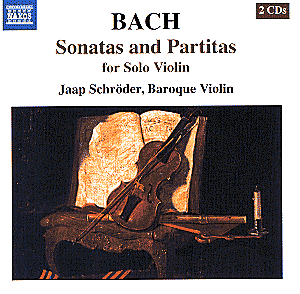In a fascinating and
extended essay which forms the bulk
of the CD booklet included here, Jaap
Schröder writes with the insight
of a historian, but the language of
a journalist. He ventures to suggest
that we've become accustomed to hearing
18th century music performed on 19th
century instruments by players who know
only a 20th century technique of playing.
His view is one shared by an increasing
number of musicians and music-lovers.
Drastic changes made to the violin after
Bach's time, together with 'solutions'
to 'problems' created by those changes,
have combined to produce a modern instrument
and, inevitably, a technique of playing
it, which is fundamentally different
to indeed contrary to that which Bach
envisaged when writing this music. Schröder
cites heightened tensions in the sound
character, the development of a constant
vibrato rather than expressively selective
vibrato and a fondness among today's
players for an uninterrupted legato
stroke of the bow. This contrasts with
the articulated, flexible bow of the
past - which, he argues, "contradicts
the grandeur of old rhetorical gestures".
This recording was
previously released by the Smithsonian
Institute, and is now 20 years old;
not that you'd know it: it sounds well.
Naxos don't say so, but I assume Schröder's
essay dates from the time of that original
issue. Of course his words are as valid
now as ever they were, but it's interesting
to reflect on how far we have come in
recent years. Grumiaux, Szeryng and
Perlman are still regarded as historic
benchmarks in this repertory, but the
case for playing Bach on a Baroque violin
has surely been won. Rachel Podger's
recent set on Channel Classics, for
example, not only sounds wonderful,
and wonderfully alive, but also
enables us to hear Bach's counterpoint
and his implied-polyphonic harmony.
It does this as no modern instrument
recording does, or indeed can. Not many
21st century listeners wouldn't prefer
this approach: it has indeed become
the new norm, the new benchmark.
Standards - and not
just styles of playing - have also advanced
these past twenty years. In the early
1980s, there were comparatively few
experienced or professional players
committed to Schröder's cause,
and the notion of 'historically-informed'
(or, if you must, 'authentic') performance
practice tended also to imply an uncomfortably
strident tone and unyielding phrasing.
But I don't include Schröder, former
concertmaster of Concerto Amsterdam
and the Academy of Ancient Music, in
that generalisation. His instrument
sounds fabulous, his intonation immaculate,
and his playing is unfailingly accurate,
intelligent and affectionate.
Having said that, there
are newcomers to the Baroque stage including
not only Rachel Podger, but perhaps
also - more controversially - Lucy van
Dael, another Naxos artist. These artists
are even better able to shape and characterise
this extraordinarily complex, diverse
and demanding music. In making that
judgement, I am voicing a slight disappointment
in the sense of line projected by Schröder,
who occasionally loses the continuity
of a top-string phrase, by allowing
our attention to be deflected to a bass
note or inner part, and not having a
sufficient range of tone to be able
to pick up the original line, as if
undisturbed. Today's players are content
for their music-making to be more emotionally
and dynamically wide-ranging: especially
in a piece such as the great D minor
Chaconne, which in Schröder's
hands is intimate rather than dramatic,
innate but not explicit. Some of Schröder's
dances are polite, as if observed rather
than partaken: and some movements -
especially those distinguished by a
stream of identical note values, such
as the Corrente and Double
of the B minor - tend to sound motoric,
without obvious phrase structure or
breathing space.
However, anyone accustomed
to or offended by the heavy weather
often made by 'traditional' or 'old-school'
(i.e. modern instrument) performers
of Bach's multiple-stoppings and constantly
contrapuntal writing, must try this!
Schröder's playing may be rather
confined, but it's expert, it's beautifully
pure, and - avoiding as it does any
kind of excess - it will repay repeated
listening.
Peter J Lawson
see
also review by Zane Turner







